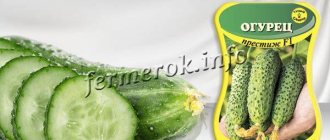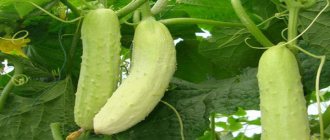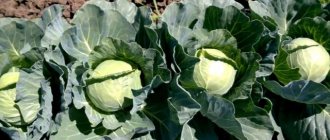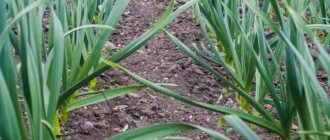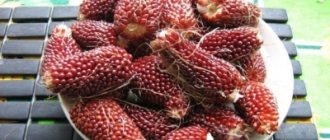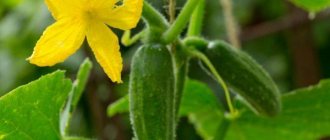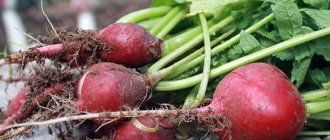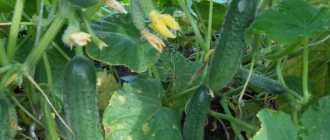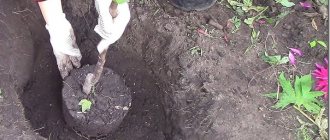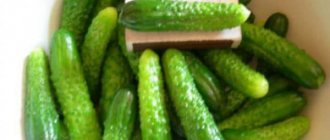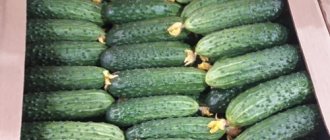A new generation hybrid - the Salinas F1 cucumber was created on the basis of a seed production facility in Switzerland; the supplier and distributor of seeds is the Dutch subsidiary Syngenta Seeds BV. The crop is relatively new to the seed market. For those who are not familiar with the variety, descriptions and reviews of Salinas F1 cucumbers will help to get a general idea of the new product.
Description of Salinas F1 cucumbers
Cucumber Salinas F1 is a tall plant of indeterminate species, grows up to 1.8 m. Intensively forms side shoots and foliage. To develop the bush, stepchildren of the first order are used, the remaining shoots are removed. The Salinas cucumber variety has average frost resistance and is cultivated in open garden beds in regions with warm climates. If the temperature drops to -140 C, the growing season stops. In temperate climates, cucumbers are grown only in a greenhouse.
The Salinas variety belongs to the group of gherkins, parthenocarpic fruiting. Produces only female flowers with 100% ovary. Cucumbers do not require pollinators. A hybrid of bouquet flowering, fruits are formed in leaf internodes of 3-5 pieces. Cucumber Salinas F1 is an early ripening variety, fruiting begins after 1.5 months, duration - until the onset of cold weather.
Description of the plant:
- The bush forms 4-5 shoots, medium volume, light green in color. The structure of the stems is hard, unbreakable, the surface is medium pubescent, the pile is sparse and prickly. The stepsons are thin and fragile.
- The foliage is intense, the leaves are dark green, located on short thick petioles, opposite. The surface is hard, finely pubescent, corrugated. The edge of the leaf blade has large teeth.
- The root system is fibrous, powerful, spreading widely to the sides, and superficial.
- The flowers are bright lemon, simple, and the Salinas cucumber blooms bouquet-like.
The crop is small-fruited, produces fruits of an even shape, the number of greens at the beginning of fruiting and the last ovaries is in the same quantity.
Important! The fruits of the Salinas cucumber variety are not prone to over-ripening; after biological ripeness, they stop growing and do not turn yellow.
The external description of the Salinas F1 cucumber corresponds to its photo above:
- fruits of regular cylindrical shape, weight – 70 g, length – 8 cm;
- during ripening, they are uniformly colored light green; at the stage of technical ripeness, a weakly detectable yellow pigment and longitudinal stripes appear on up to 1/3 of the fruit at the place where the flower is fixed;
- the peel is thin, hard, resists mechanical stress well, and provides the cucumber with a long shelf life;
- the surface is glossy, finely tuberous, the main concentration of tubercles is near the stalk, medium pubescence;
- The pulp is juicy, dense, white, without voids.
Cucumber Salinas F1 is suitable for growing in a personal garden or summer cottage and in large farm areas. It tolerates transportation well and has good keeping quality. Shelf life is more than 14 days.
Description of Mexican cucumber, growing technology and yield
Mexican cucumber, a plant rich in beneficial properties, has long been used in countries and regions of Russia with warm, subtropical conditions. Nevertheless, this vegetable surprises many buyers at the market.
Peculiarities
Some people think that Chayote grows only in Mexico, but in open ground it can be found in the subtropics of the Caucasus, Crimea, and Krasnodar Territory. Catalogs in the pumpkin section contain chayote varieties. In the description, this plant is represented as a densely branching vine. A Mexican cucumber entwines a nearby fence, trees, and supports collected for it.
The leaves of the plant are juicy, large, and shaped like pumpkins. The fruits are special; green or milky color of the fruit depends on the variety. The wrinkled surface of some varieties of vegetables is covered with thorns. The fruit is pear-shaped and contains a large seed inside, about 5 cm in size.
The underground part of the chayote has root vegetables that are eaten in the same way as potato tubers. They synthesize vitamins B and C, a complex of amino acids, and starch.
Benefits of chayote
The Mexican cucumber is used not only for food. The above-ground and underground parts of the plant have medicinal properties and are used in folk medicine. Healers make recipes for the treatment of the following ailments:
- disorders in the digestive system;
- salt formations (stones) in the kidneys;
- persistent increase in blood pressure (hypertension);
- chronic arterial disease (atherosclerosis).
Chayote leaves are used as a medicinal component. The remedy is prepared by brewing vine leaves. After infusion, drink the decoction.
Home craftsmen learned to process and use the rough ground part of the plant to weave baskets, bags, hats, and mats.
Growing technology
Chayote (Mexican cucumber), the cultivation of which does not require any special measures, is planted in warm places in early spring at the end of April using the seedling method. The end of May, the first week of June is the time to plant seedlings in the beds.
Planting pattern: in a row, the distance between shoots should be at least 1 m. The hole for seedlings is filled with humus and 100-150 g of nitrophoska are added. After planting, the plants should be watered with warm water.
Cut branches can be used as planting material. To do this, they are rooted by placing them in damp sand. After some time, the shoots will give roots, they are planted in a permanent place. The ends of the branches on the seedlings are also pinched.
Simultaneously with pruning the seedlings, supports are installed nearby. During the growth and development of chayote, it is regularly watered, the soil is loosened and weeds are weeded. It is recommended to hill up grown plants and feed them with cow manure, preparing a solution of 1:10. Use mineral fertilizers for regular fertilizing.
Harvesting
On the eve of autumn, when there are 12-13 hours of daylight, it is time for the Mexican cucumber vine to bloom. The resulting fruits develop, acquire a shape and color corresponding to the variety. The ripened harvest must be harvested before the cold weather.
In warm regions, chayote is grown as a perennial crop. In the first year, 80-100 large fruits can be collected from each bush. Mature plants that have gained strength are capable of producing a harvest of up to 300 fruits.
Harvested, well-ripened cucumbers are stored in a cool place on the bottom shelf of the refrigerator or in the cellar. The keeping quality of the fruits is very good; they are stored until spring without changing their appearance and taste.
In areas with harsher winters, chayote is grown as an annual crop and the fruits are harvested when unripe. They are edible and taste like young cucumbers. A fully ripened harvest can be obtained by growing the vine in a greenhouse.
After collection, with the onset of cold weather, the vine is cut, laid on the ground, covered with leaves (covering material can be used) and sprinkled with earth.
Chayote is a crop that can be used for landscaping balconies and verandas. It is also suitable for growing as a potted crop. A beautiful leafy green mass will decorate any green corner.
Taste qualities of cucumbers
Gherkins of the Salinas variety have a high gastronomic rating, taste sweet and juicy. There is no bitterness even with irregular watering. Overripe fruits do not change their taste; there is no acid. Cucumbers are widely used. They are consumed fresh and used as an ingredient for assorted vegetables.
The small-fruited Salinas cucumber variety is ideal for pickling and preservation. The presentation and color do not change after hot processing; the gherkins fit compactly into a glass container. The taste of pickled and pickled cucumbers is balanced, the flesh is crispy, dense, and no void is formed in place of the seed chambers.
Landing
Cucumbers can be grown through seedlings in all regions of Russia and neighboring countries, and sown with seeds directly into the ground in the south. To obtain seedlings in the middle zone, Siberian Garden seeds are planted in April (at the beginning of April - for greenhouse cultivation, in the middle or end - for open ground). You can sow directly into the soil when its temperature reaches a stable +16.
Nutrient soil is prepared for seedlings from:
- 1 part of soil from the garden;
- 1 part peat;
- 1 part sawdust, sand or vermiculite;
- 2-3 parts of humus.
Then the composition is spilled with a hot solution of biofungicide or potassium permanganate to kill bacteria, viruses and parasite larvae. If necessary, add fertilizers - a little wood ash, ammophosphate or superphosphate. Cups made of peat or plastic are filled with the substrate.
Seeds are sown to a depth of no more than 1.5-2 cm. Before sprouts appear, the pots are placed in a warm room at +25-27 degrees. After germination, the sprouts are provided with a temperature of +20-22 during the day and +18-20 at night.
The period for growing seedlings is 25-30 days. You can feed her once.
A bed for cucumbers is chosen in a sunny place, protected from wind and drafts, not in lowlands, so that water does not stagnate there. A neutral soil with an acidity of 6-7 pH is required. If the acidity is high, it is knocked down with dolomite flour, ash, chalk, and slaked lime.
You should not plant cucumbers after pumpkin and melon crops. Optimal predecessors in the garden:
In the fall, the site must be dug up and fertilized with organic matter. Seeds are sown according to a pattern of 50 by 30 cm.
Pros and cons of the variety
Cucumber Salinas F1 is characterized by a number of advantages:
- early ripening;
- high degree of fruiting;
- leveled gherkins;
- not subject to aging;
- can be stored for a long time;
- resists mechanical stress well;
- unpretentious to grow;
- yield does not depend on the growing method;
- has stable immunity.
The downside is the inability of the hybrid to produce full-fledged planting material.
Culture breeding methods
The hybrid can be grown by direct sowing of seeds in beds or by seedlings. First, the seeds are disinfected with potassium permanganate and then wrapped in cotton cloth soaked in water. Until the planting material has thrown out its roots, the fabric is moistened every day, but not watered. After the seeds germinate, they are sown in the beds. Sowing depth 30-40 mm. If night frosts are expected, then cover the soil with warm cloth or film.
To obtain seedlings, seeds are sown in boxes with light soil, which is fertilized with organic fertilizers. After about 6-10 days, the first shoots will appear. It is recommended to water them with warm water once every 5 days. The seedlings are fed with complex mineral fertilizers. When the seedlings are 20 days old and each sprout has 4-7 leaves, the plants are transplanted to permanent soil.
The bed is loosened, disinfected with potassium permanganate or another preparation, and fertilizers (organic or mineral, water-soluble mixtures) are added to the soil. The hybrid is planted according to the 0.5x0.3 m scheme. The optimal number of plants per 1 m² of sown area should not exceed 4 units. If a greenhouse is used for breeding a hybrid, then it is recommended to place 5-6 bushes on the specified area.
Optimal growing conditions
The main condition for growing in a greenhouse is the creation of a favorable microclimate. The optimal temperature for the growing season is 230 C, daylight hours are 8 hours, no additional lighting is required. Mandatory installation of support. High air humidity.
For cultivation in open ground, choose an illuminated area on the south or east side. The culture is not afraid of shading at certain times of the day. Cucumber does not react well to drafts. The composition of the soil should be neutral, fertile, without stagnant moisture.
Care
The yield of the variety increases compliance with the rules for growing the crop. Cross-pollination of flowers is increased by mixed plantings of cucumber bushes. The cucumber variety Rodnichok is planted in the same area with the Atlet hybrid. Bees are attracted for pollination by planting honey plants.
The number of female flowers on a plant is increased by temporarily suspending watering before the flowering stage. The first ovary is removed. The root system will become stronger and receive an additional portion of nutrition for future fruiting.
The stem is ringed in dry weather. Make a small cut under the first leaf. Nutrients will remain in the stem and will be used to lay a new ovary.
Watering
Cucumbers of the Atlet F1 variety do not tolerate excess or lack of moisture. The soil is moistened to a moderate state. Watering is carried out with warm water to reduce the likelihood of disease development. Regular irrigation will ensure a high yield. Use drip irrigation or sprinkling from a watering can.
Do not allow the leaf mass to wilt. The root system of cucumbers is shallow. The condition of the plant is negatively affected by the drying out of the top layer of soil. In hot weather, watering is carried out daily.
Garter and bush formation
When the length of the lashes is 30-45 cm, the plants begin to be tied up. Elastic materials are used: nylon threads, rags, twine. The upper end of the rope is attached to the ceiling of the greenhouse
The lower part is carefully passed between the cucumber leaves. The stem will twist around the rope as it grows
Description of the beneficial properties of tying cucumbers of the Athlete variety:
- the area of plant illumination increases;
- the stems are better ventilated;
- the lashes grow freely;
- the entire ovary is preserved;
- easier to care for cucumbers;
- convenient to harvest.
For abundant fruiting of cucumbers, the formation of a bush is required. Athlete vines are pinched. Part of the ovary is removed. The roots of the plant are not able to provide nutrients for the entire future harvest. At the first five nodes, all stepsons and nodes are removed. The lower part of the main vine of cucumbers should be well ventilated.
Top dressing
The Athlete F1 variety has active growth and fruiting. Cucumbers need feeding throughout the growing season. From the moment of emergence, fertilizers are applied 1-2 times per month. Seedlings of the Atlet variety are fertilized with mineral complexes with a high nitrogen content. Cucumbers grow strong greens.
After entering the greenhouse, the cucumbers are given two weeks to adapt. After 15-20 days, they begin to introduce fertilizing. Use solutions of ash, chicken droppings, and mullein. At the stage of bud formation, potassium supplements are added.
By external signs one can judge the lack of a nutrient element for a cucumber variety:
- underdeveloped, pointed fruits indicate a lack of nitrogen;
- drying of the tops indicates phosphorus deficiency;
- wide, short cucumbers are formed with a small amount of potassium.
Hilling
Surface loosening of the soil is carried out. The cucumber root system has a fragile structure. To prevent damage to the roots, use a fork or rake. The earth is pierced to a shallow depth.
Growing cucumbers Salinas F1
Salinas F1 cucumber is grown using seedlings and direct planting of seeds in the ground. The seedling method is used regardless of the climate. Direct landing is recommended for the Southern regions.
Direct planting in open ground
Before planting on the plot, Salinas cucumber seeds are placed in the refrigerator in a wet cloth for a day. Material is sown on the site in the middle or end of May, depending on how warm the soil is, the optimal indicator is +180 C. Planting work:
- They dig up the area in advance and add organic matter.
- Make holes 1.5 cm deep.
- Put 2 seeds, the germination rate of plants of this variety is good, this amount will be enough.
- Fall asleep and moisten the bed well.
- After germination, one strong sprout is left in the hole.
The distance between the holes is 45-50 cm, 2-3 plants are planted per 1 m2. The sequence and scheme for planting Salinas cucumbers in closed ground and open beds are the same.
Growing by seedlings
The timing of sowing seeds for seedlings is determined by the climate; after 30 days, the cucumber can be planted in the garden. The work is carried out around mid-April. Landing algorithm:
- Take peat containers, pour a nutritious mixture of sand, peat, compost in equal parts into them, and you can plant them in peat cubes.
- Make 1.5 cm indentations and place one seed at a time.
- Place in a room with a constant temperature (+220 C).
Cucumbers do not take root well after transplantation; they are placed in peat containers on the site.
Watering and fertilizing
Hybrid Salinas F1 requires watering; cucumbers are moistened every evening at the root with a small volume of water. In the greenhouse, they are watered in the same mode using the drip method. Fertilizing is given in the spring before flowering, using a product containing nitrogen. At the time of fruit formation, fertilize with superphosphate. After 3 weeks, potassium fertilizers are applied.
Formation
A bush of cucumbers of the Salinas variety is formed by 4 lower shoots. As it grows, it is fixed to the trellis. The side shoots are cut off; a lot of them are formed. Leaves that have no ovary in their internodes are removed. After harvesting the fruits, the lower leaves are also removed. The top of the cucumber is not broken; as a rule, it does not grow higher than the trellis.
Protection from diseases and pests
The Salinas F1 variety has stable immunity to infection and pests. A cucumber in a greenhouse does not get sick; in an unprotected area in a cold, rainy summer, it can be damaged by anthracnose. It is difficult to reduce humidity during precipitation; the plant is treated with colloidal sulfur. For preventive purposes, before flowering, cucumbers are sprayed with copper sulfate. Pests do not attack the plant.
Diseases and parasites
Cucumber plants of the Salinas f1 variety are highly resistant to powdery mildew, cucumber mosaic and pests. A description of some of the diseases that may appear is given below.
Anthracnose
The disease first affects borage foliage. Pale spots form on it, which quickly increase in size. The leaves turn brown and dry out. Depressed ulcers appear on the stems and fruits of plants.
The disease can affect the Salinas variety, as it is fungal and infectious in nature. It can be carried by the wind from another area, through untreated equipment, or through undisinfected soil on which the diseased plant previously grew. This disease appears mainly when cucumbers are grown in greenhouses. The yield is significantly reduced. If you start the disease without taking any action, the plant will die.
To prevent this type of infection, preventive measures are taken: they use equipment treated with an antiseptic, disinfect the soil and greenhouse, regularly ventilate the greenhouse, and purchase seeds from trusted manufacturers.
To treat anthracnose, cucumber bushes are treated with fungicidal preparations.
Ascochyta blight
The cucumber variety Salinas f1 can also be affected by a disease such as ascochyta blight. Description of the disease: a fungal infection that affects the leaves, stems and fruits of the plant. It is carried by air flow from another area, transmitted with contaminated seeds, through untreated soil or garden tools.
Small gray spots form on the foliage and grow quickly. Then black spots appear, which move onto the stem and fruits. Cucumbers turn black, rot, and become unfit for food. For prevention, you should regularly ventilate the greenhouse, treat the soil and all greenhouse structures before planting, and use clean equipment. For treatment, a mixture of chalk and copper sulfate (1:1) is used, which is coated with the stems.
Root rot
Excessive moisture can cause root rot to develop on Salinas cucumber bushes. The leaves, stems and roots of cucumber plants become thinner, turn yellow, and dry out. Fruiting stops, and the crop soon dies. It is almost impossible to cure the disease. In the early stages, you can treat the roots with copper sulfate and wood ash (a mixture of 2 teaspoons of vitriol, 100 g of ash).
To prevent the development of root rot, it is recommended to carefully monitor the watering of cucumbers, avoiding overwatering.
Productivity
The early ripe cucumber Salinas F1 begins to bear fruit in mid-June if it is grown in a greenhouse, in an open garden – 7 days later. Fruiting continues until September. Ultraviolet deficiency, a reasonable decrease in temperature and untimely watering do not affect the formation of fruits, the yield is stable. Up to 8 kg of gherkins are removed from one bush, and within 15-17 kg from 1 m2.
Advice! To extend the fruiting period, cucumbers are planted at intervals of 15 days. For example, one batch - at the beginning of May, the next - in the middle, sowing seedlings is carried out with a difference of 2 weeks.
Characteristics
Cucumber Salinas F1 exhibits relative resistance to low temperatures. Vegetation and fruit set are suspended if it is +14 degrees outside. The first cucumbers can be harvested after 38-40 days. The yield per plant is 9-10 kg, and from 1 sq. m. - about 17 kg.
Important! A lack of sunlight, as well as untimely watering, do not affect the formation of the Salinas F1 ovary.
To increase productivity, it is necessary to timely fertilize and loosen the soil at the base of the plants, which will improve the flow of air to the roots.
The hybrid easily tolerates heat and at the same time shows stable yields
Advantages and disadvantages
Despite the fact that the Salinas F1 cucumber has a number of advantages, which allows it to compete well with other types of crops, it has several disadvantages that should be taken into account. This information will allow every gardener to get a complete picture of this hybrid.
The main advantages of Salinas F1:
- early ripening;
- drought-resistant;
- self-pollinating;
- has good natural immunity;
- characterized by excellent taste;
- withstands transportation and long-term storage up to 2 weeks;
- consistently high yield, regardless of growing conditions;
- cucumbers are resistant to aging;
- universal fruits;
- one-dimensionality of gherkins.
The disadvantages of Salinas F1 include the inability to collect seeds for sowing, which increases costs. As well as average yields for the hybrid form of the crop.
How to care for crops
To get the maximum benefit from the Pasalimo F1 cucumber variety, they need to be well looked after and harvested in a timely manner.
Watering and fertilizing
Cucumbers of the Pasalimo F1 variety need regular and proper watering. Insufficient watering negatively affects the yield and taste of this vegetable.
It is recommended to water the plants approximately once every 5–7 days. But it is worth noting that the amount of watering depends largely on weather conditions. In hot weather, watering should be done more often, every 1-2 days, and when rainy weather occurs, watering should be stopped.
Watering is carried out according to the following calculation - about 1 bucket of water is used for 1 m² or for each adult bush. It is best to use the drip irrigation method. In sunny weather, you should water only at the roots, as moisture on the leaves can cause sunburn. It is best to carry out this process in the evening hours.
Find out also how to water cucumbers in a greenhouse correctly and how often.
To maximize the yield of the crop, it is necessary to carry out at least 3–5 feedings during the entire growing season. Lack of nutrients leads to cucumbers becoming small, losing shape, color and taste.
The first feeding is done when the first shoots appear. To do this, use organic fertilizers - rotted manure or bird droppings. Such organic matter with a volume of 1 liter is diluted in 10 liters of water, 0.5 liters of wood ash are added, as well as mineral fertilizers (15 g of urea, 50 g of superphosphate, 15 g of potassium sulfate). During the period of fruit ripening, the volume of nitrogen and potassium fertilizers is doubled.
It is also useful to carry out foliar feeding. To do this, you can spray every 14–20 days with a solution prepared from the following ratio: 5 g of ammonium nitrate, 10 g of superphosphate and 8 g of potassium sulfate per 10 liters of liquid. One bucket with a volume of 10 liters is enough for a 30 m² area with planting.
Forming and tying a bush
To ensure proper formation of the bush, pinching is done. When 6-7 leaves appear, the main stem is pinched above the 5th or 6th leaf - this stops the plant’s growth in height and promotes the appearance of side vines, on which the ovary will subsequently appear, which will greatly increase the yield of the plant crop.
To prevent the fruits from ending up on the ground and starting to rot, the vines of the plant must be tied to pre-installed trellises. To install them, supports made of wood or metal 1–1.2 m high are dug into the ground, and a rope or wire is pulled between them. The whips are tied to this structure.
Important! Old women's tights, soft rags or ribbons are used as material for garters. It is necessary to use only fabric that is soft in structure so as not to damage the shoots.
Soil care
After watering, you should loosen the soil around the cucumbers to a depth of about 5–7 cm. This will prevent the appearance of a crust on top of the soil and improve the flow of water and air to the plant crop. Simultaneously with loosening, weeds are removed, which draw moisture and nutrients from the soil.
To prevent drying out, as well as to prevent the appearance of weeds, it is recommended to mulch the soil near the bushes. Straw, peat, sawdust, manure, and humus are used as mulch.
Diseases and pests of the variety
Cucumbers of the Pasalimo F1 variety are resistant to diseases such as powdery mildew, cladosporiosis, and cucumber mosaic.
If you observe crop rotation and carefully care for this plant crop, then no diseases are scary. But watering with cold water, heavy cold rains, lack of solar heat, and temperature changes can provoke the appearance of certain diseases, including various types of rot. To combat such diseases, appropriate chemical preparations are used (Fitosporin, Bordeaux mixture).
whitefly
The best varieties of cucumbers for pickling for 2021
Herman F1
An old acquaintance whose seeds are sold by many companies: Agros, Ural Summer Resident, House of Seeds, Search, Russian Vegetable Garden, etc. Invariably, year after year, it pleases its followers not only with the volume of the harvest, but also with the excellent quality of cucumbers.
It is grown in beds and in protected soil. It doesn't taste bitter. in more detail in the special material “SiO”.
Artist F1
Seeds can be found from several companies: Search, Ural Summer Resident, Agroelita, Elkom, Gavrish, etc. Dutch hybrid that does not require pollination. Suitable for any type of cultivation, including growing quietly not only in sunny places, but also in partial shade. Resistant to many viral and bacterial infections. Full description
is in a separate article on our portal.
According to reviews, it is the Gavrish company that is the originator of this variety and the plants from these seeds are closest to the declared properties. A fairly popular hybrid that has shown consistently good results in 2021. Actively grown in any type of soil. We love it among vegetable growers for its lack of bitterness. One of the few varieties that are good to salt in a barrel. A separate C&O material is devoted to the Murashka F1 variety.
Adam F1
Seeds of this variety can be found from the following companies: Siberian Garden, Search, Agrostil, Gavrish, Prestige, etc. A shade-tolerant Dutch hybrid that has become a favorite of many summer residents, despite its mid-ripening. It is famous for its high yields and resistance to various cucumber diseases. Detailed Specifications
can be found in a special article.
Cucumbers are considered ultra-early in terms of ripening if the opportunity to pick the first cucumbers appears before the period of 40 days from germination has elapsed. Such varieties are often used for sowing in two rotations. In this case, during the second rotation (summer-autumn), the hybrids begin to set fruit even earlier. However, it is worth considering that when sowing in a bed without shelter, the date of fruit appearance may be delayed by 7-10 days.
Russian hybrid. The lashes are average. The growth of lateral shoots is scanty. Flowers are female. Ovary in a bunch of 4-5 pieces. Large tubercles. The color of large tuberous cucumbers is dark green with white stripes (Russian shirt). Length up to 8 cm. According to reviews, it bears fruit well in almost any conditions. Equally good in a salad or in a twist.
Heat-resistant and cold-resistant Turkish hybrid. Tied under any conditions. A bunch of 3-5 pieces. Fruits for a long time, until cold weather. Cucumbers of the correct shape. The tubercles are large. Length up to 14 cm. Vegetable growers liked it for its phenomenal resistance to negative weather conditions (heat, cold, cloudy, too humid). It recovers well after any weather disasters. Equally suitable for fresh salad and pickling.
Dutch hybrid. The lashes are average. Flowers are female. The tubercles are small. The pubescence is white. Vegetable growers separately note their rapid development from the seedling stage and the early onset of fruiting. Universal use.
Cucumbers are considered mid-season if fruiting begins approximately 50-60 days after germination. Such varieties, when sown simultaneously with early ones, make it possible to fill the gap between two whorls. If you sow them a little later, you can enjoy fresh fruits before frost.
Turkish hybrid. This variety is considered mid-season when grown in the first rotation (spring-summer). In the second revolution (summer-autumn), ripening begins much earlier (after 30-35 days). Feels good in unprotected soil in the climate zone of Central Russia. It is calm about growing without formation.
The lashes are average. The tops are powerful, the leaves are large. Short internodes. Large tubercles. Length up to 13 cm. Thin skin. According to reviews, in comparison with Vyatich, there is a smaller number of ovaries in general, but the yield is still high. Responds well to feeding. Can be used on salads and for canning.
Dutch hybrid. The bush is powerful. The lashes are average. Flowers are female. Ovary 3-4 pieces in a bunch. The tubercles are small. The spines are white. Length up to 10 cm. Vegetable growers specifically note the possibility of obtaining a decent harvest in any summer. It can be easily grown in the Urals, Siberia and northern regions. The purpose of the variety is universal.
Japanese hybrid. This variety is considered ultra-early. The bushes do not grow too much, which is convenient for garden beds. Weakly braided. Cucumbers are very prickly. The skin is not tough. Cucumbers are often tuberous. Length up to 12 cm. Does not grow into thickness. It is loved by many summer residents because it sets fruit perfectly even in the absence of favorable conditions. Can be used fresh and for preservation.
Cold-resistant Dutch hybrid. This variety is considered early ripening. Has good adaptability and stress resistance. The bushes are medium-sized. Leaves are sparse. Cucumbers with thin skin. The tubercles are small. Vegetable growers like stable, uniform yield throughout the entire fruiting season. Good for salads and pickling.
Dutch hybrid. This variety is considered mid-early. An adult bush does not grow beyond average size. Climbing ability is also average. Gherkin cucumbers are white-thorned and finely tuberculate. Length up to 12 cm. Gardeners specifically note its productivity against the background of increased resistance to various climatic and weather quirks. They also like the long-term fruiting of the variety. The fruits can be used for any dishes.
Despite the fact that bees are needed for pollination, it has shown good results in unprotected soil for many years in a row. This variety is considered early ripening. The lashes are long. Mixed flowers. The ovary is single. The tubercles are quite large, but sparse. Length up to 11 cm. We love gardeners for long-term fruiting, cold resistance and taste when pickling.
Dutch hybrid. This variety is considered ultra-early ripening. Doesn't need shaping. The bush is compact. Flowers are female. The harvest is given quickly and amicably. The cucumbers are brown-thorned, with large tubercles. Length up to 12 cm. Gardeners like it for its resistance to adverse conditions and diseases. The purpose is universal.
Swiss hybrid. This variety is considered early ripening. The lashes are average. Flowers are female. Ovary bunch up to 6 pieces. The harvest yield is friendly. Cucumbers with very delicate skin and a bright aroma. The tubercles are small. The spines are white. Length up to 9 cm. Vegetable growers like it for its long fruiting until frost and its keeping quality. It is considered a universal variety. Ideal for canning gherkins.
Russian hybrid. This variety is considered mid-early. Branching is average. Flowers are female. The fruits are given away together. Many ovaries are formed at the same time. White-thorned, chat-tuberculate cucumbers. Length up to 11 cm. Resistant to diseases. Vegetable growers love it as a productive variety. Use – universal. Ideal for preparations in the form of pickles and gherkins.
Advantages and disadvantages
Pros:
- excellent taste;
- universal application;
- rapid ripening;
- high productivity;
- resistance to cladosporiosis, tolerance to powdery mildew and cucumber mosaic;
- self-pollinating;
- long fruiting period.
Cons: Pros:
- high taste qualities;
- beautiful appearance;
- excellent keeping quality and transportability;
- high productivity;
- early ripeness;
- the ability to form greens without pollination;
- the fruits do not outgrow;
- unpretentiousness;
- immunity to many diseases.
Minuses:
- it is impossible to obtain seed material.
